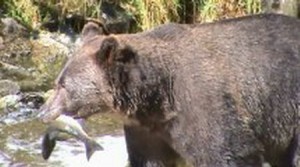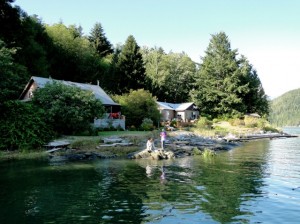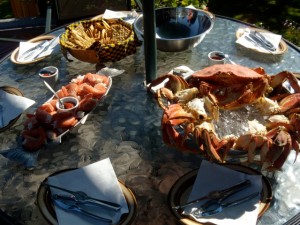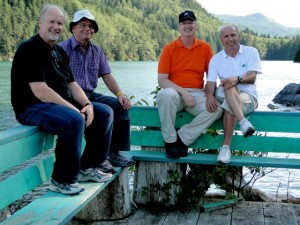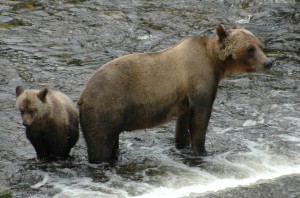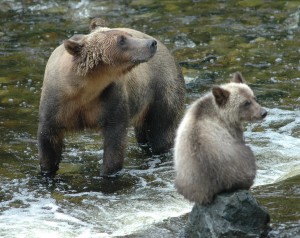Grizzly Bear and Wildlife Tour Blog
We offer an exceptional fly-in lodge for Grizzly Bear Watching and Whale Watching in British Columbia.
Learn about What’s happening at the Lodge, view our British Columbia’s Wildlife Report, read our Grizzly Bear Watching Blog and Whale Watching Blog. Learn more about a Day on the River Blog, see Our Tour Guide’s Photos & Blog and Photos from Our Guests.
The Four Austrians 2 of 11
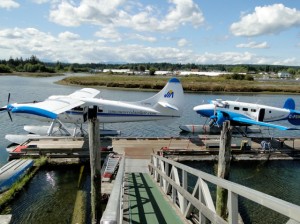
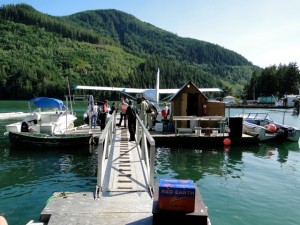 The first photo is a view of the departure dock in Campbell River. Guests leave Campbell River on Vancouver Island once they all arrive and their luggage (any extra room on the plane is filled with food for the lodge) is loaded. Departure by 3:00 or earlier is possible. The flight to the lodge is approximately forty-five minutes and be sure you have your camera ready, as there are some great photo opportunities over the coastal inlets and mountains. Once you arrive there is about thirty minutes of controlled chaos. Often there are eight guest coming and eight guests departing. The arriving guests want to hear for the departing guests how their trip was to gage their chance of success and normally the departing guests want to stretch their stay as long as possible so are glad to talk. Within all this we need to exchange luggage on the plane, incoming for out going, as well as unload any food we managed to get on board. The high tide provides a level ramp and makes us all happy when we carry luggage and food boxes to the lodge.
The first photo is a view of the departure dock in Campbell River. Guests leave Campbell River on Vancouver Island once they all arrive and their luggage (any extra room on the plane is filled with food for the lodge) is loaded. Departure by 3:00 or earlier is possible. The flight to the lodge is approximately forty-five minutes and be sure you have your camera ready, as there are some great photo opportunities over the coastal inlets and mountains. Once you arrive there is about thirty minutes of controlled chaos. Often there are eight guest coming and eight guests departing. The arriving guests want to hear for the departing guests how their trip was to gage their chance of success and normally the departing guests want to stretch their stay as long as possible so are glad to talk. Within all this we need to exchange luggage on the plane, incoming for out going, as well as unload any food we managed to get on board. The high tide provides a level ramp and makes us all happy when we carry luggage and food boxes to the lodge.
The Four Austrians 1 of 11
This is the story of four great guys, “the team consisting of the 4 Austrians Ingo, Sigurd, Walter and Heinz”. They say it best in their own words: “Please find below as required some fotos from our stay in your lodge in August this year. It gave us great moments and unique memories of a fantastic fauna in overwhelming nature.I hope you can use it in your website and show it to guests who are interested what their stay in the lodge would be all about. We appreciated very much the whole setup, means the lodge, the trips, the food and all the care you and your team provided for us.All in all it was a very successful choice to book your program and we can only highly recommend it to all who love to explore nature and stay in a lodge which is very small (only 8 guests at a time) and allows therefore very personal but professional care.Thanks again for everything and best regards to everybody there.The team consisting of the 4 Austrians Ingo, Sigurd, Walter and Heinz”
Northern Resident Orca Identification
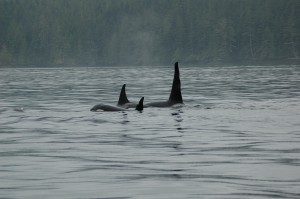
If you have the time to open another browser click here
Killer Whales of the Northern Resident Community
northenresidentorcas.blogspot.com// you will be in a website which identifies all the orca that we observe each summer. The map area in red shows the area frequented by the northern resident orca and this is basically the area we cover when we go on our whale-watching safari. If you click on “A1 pod – A30 matriline” and scroll down until you come to “A72 Bend” if you look closely you will discover that this one of the orca in the photo. Some great video of the orca the orca is provided the second one has sound.
Cubs waiting to for salmon
The mother grizzly bears on the Glendale River bring their cubs with them when they come to fish. These first year cubs born in January or February are waiting patiently for a meal to be provided. One is lucky in that it has a dry rock to sit on while the other looks less sure balanced on a wet and likely slippery rock. It is not uncommon to have an age mixture in the grizzly bears we view from the stands in the fall. A mixture from first year cubs with mothers, sub-adult bears as well as fulls adults. The abundance of salmon to eat and the short time to fatten for the winter does not allow time for much fighting.
Grizzly Bear Claws
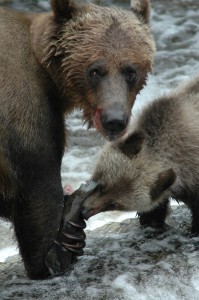
The “North American Bear Center” website says “Brown bear (grizzly bear) claws are long and curved, ranging in color from yellow to brown. In rare cases grizzlies have been observed with white claws.” This seems rather mundane and clinical until you actually look carefully at this picture. Click on the picture to enlarge it and you will notice the size of the claws. A quote from the “Fish BC” website about the pink salmon this grizzly is holding is interesting. “Easily identified by the large browny spots on their tails, pink sport aquamarine dorsal surfaces, the tiniest bright silver scales in the ocean and an over-abundance of disease-preventing slime. Accordingly, commercial fishers call them “slimies”. And they are slimy indeed. The angler is cautioned to clean up the boat after each salmon or risk ending up in the water with the rest of them.” Slime or no slime this grizzly holds the salmon in one paw while she shares with her cub. Notice that the claw raps around the fish from both sides like a hand. If you stay in the lodge the extra day and travel to the wild river many of the grizzlies in that area have the white claws.
Grizzly Bear coming to visit
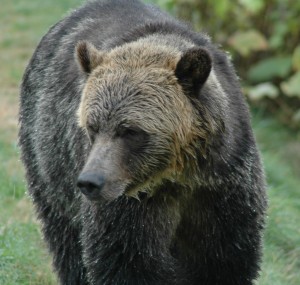
When you can see the water drops on a grizzly’s coat you know that it is coming close. The viewing area the lodge has access to on Knight Inlet’s Glendale River has two stands on either end of a narrow finger of land that separates the entrance to the man-made spawning channel and the main river. This finger of land provides a one way road to drive between stands which allows the van to park next to the stand so it is only a few feet until you are safe in the stand. However it also provides a good path for the grizzlies to use as this picture from Lindy Taylor shows. Bears will walk in front of and beneath the stands which provides great opportunities for pictures.
Grizzly Bear Eating the Catch
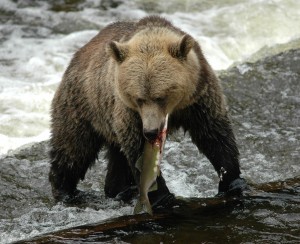
This grizzly bear seems to be devouring the salmon headfirst. The time of the year determines what part of the salmon the bears will eat. The photo by Lindy Taylor was the start of September when the pink salmon first appear in great number so the whole fish is consumed. As the season progresses they eat on the really fatty parts, such as the brain and the ovaries packed with eggs and the skin – giving them maximum calories per bite. This selective eating by the successful grizzlies provide food for bears that are less able to catch live salmon. The discards drift down stream and become meals for other bears and the ever present bald eagles. One of the viewing stand is by a deeper water pool and some bears just sit and scavenge all day this sure saves energy and that helps puts on the fat layer.
All fishers are not created equal
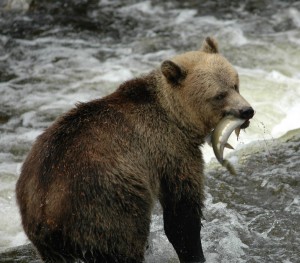
Just as all grizzly bears are not the same size or the same colours not all have the same ability when it comes to catching salmon. The fall viewing area on Knight Inlet’s Glendale River has an abundance of pink salmon and this attracts the bears. The estimated of grizzly salmon consumption runs from 40 to 100 pounds in a day depending on the size of the bear. Even if you take a low number of fifty pounds considering the pink salmon average weight are 3.5 to 4 lbs. They still need at least 12 to 15 fish a day to fatten for the winter. Bigger bears allot more. Bears fishing for salmon is not a hobby it is a lifestyle.
Successful fishing
The reason we travel up Knight Inlet to the Glendale River and to the viewing stands is to obtain pictures such as this one provided by Mike and Christina from Florida. In the fall we are able to spend two hours a day, between 10 am and 12 noon, observing the grizzly bears as they catch and eat salmon to fatten up before winter hibernation. The pink salmon in particular is the primary food source for grizzly bears in late summer to early fall. The rock turning on the beach in early summer and the many berries that are available are important food sources but it is the salmon that add that necessary layer of fat.
